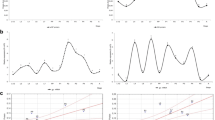Abstract
The level of amylase activity in larvae and adults of Drosophia melanogaster is dependent on the dietary carbohydrate source; flies or larvae from a food medium containing starch show higher levels of activity than individuals from a food containing simple sugars. This is shown to be due to repression of activity by sugars rather than enhancement of activity by starch. Moreover, the changes in enzyme activity reflect a change in enzyme quantity rather than a change in catalytic efficiency. The seeming stimulation of amylase activity by sucrose in some experiments is due, simply, to comparisons with “starvation” diets which cause a large nonspecific reduction in enzyme activity. Though all strains tested showed repression of enzyme activity by simple sugars, the degree of repression varies between strains. Also, in those strains which carry a duplication of the amylase structural gene, the two isozymal forms of amylase can be differentially repressed by dietary sugars.
Similar content being viewed by others
References
Abraham, T., and Doane, W. W. (1978). Genetic regulation of tissue-specific expression of Amylase structural genes in Drosophila melanogaster. Proc. Natl. Acad. Sci. USA 754446.
Bahn, E. (1967). Crossing over in the chromosomal region determining amylase isozymes in Drosophila melanogaster. Hereditas 581.
Bernfeld, P. (1955). Amylases. In Colowick, S., and Kaplan, N. (eds.), Methods in Enzymology Academic Press, New York, Vol. 1, pp. 149–158.
Doane, W. W. (1969). Amylase variants in Drosophila melanogaster: Linkage studies and characterization of enzyme extracts. J. Exp. Zool. 171321.
Doane, W. W. (1970). Drosophila amylases and problems in cellular differentiation. In Hanly, E. W. (ed.), RNA in Development (Int. Symp. Prob. Biol., 1, 1969), University of Utah Press, Salt Lake City, pp. 73–109.
Doane, W. W., Abraham, I., Kolar, M. M., Martenson, R. E., and Deibler, G. E. (1975). Purified Drosophila α-amylase isozymes: Genetical, biochemical and molecular characterization. In Markert, C. L. (ed.), Isozymes Academic Press, New York, Vol. IV, pp. 585–607.
Hickey, D. A. (1977). Selection for amylase allozymes in Drosophila melanogaster. Evolution 31800.
Hickey, D. A. (1979a). Selection on amylase allozymes in Drosophila melanogaster: Selection experiments using several independently derived pairs of chromosomes. Evolution 331128.
Hickey, D. A. (1979b). The geographical pattern of an enzyme polymorphism in Drosophila melanogaster. Genetica 511.
Hickey, D. A. (1981). Regulation of amylase activity in Drosophila melanogaster: Variation in the number of enzyme molecules produced by different amylase genotypes. Biochem. Genet. 19783.
Hjorth, P. J. (1979). Genetic variation in mouse salivary amylase rate of synthesis. Biochem. Genet. 17665.
Hoorn, A. J. W., and Scharloo, W. (1978a). The functional significance of amylase polymorphism in Drosophila melanogaster. I. Properties of two amylase variants. Genetica 49173.
Hoorn, A. J. W., and Scharloo, W. (1978b). The functional significance of amylase polymorphism in Drosophila melanogaster. V. The effect of food components on amylase and α-glucosidase activity. Genetica 49181.
Hosbach, H. A., Egg, A. H., and Kubli, E. (1972). Einfluss der futterzusammensetzung auf verdauungsenzym-aktivitaten bei Drosophila melanogaster-larven. Rev. Suisse Zool. 791049.
Kikkawa, H. (1964). An electrophoretic study of amylase in Drosophila melanogaster. Jap. J. Genet. 39401.
Laurell, C. G. (1966). Quantitative estimation of proteins by electrophoresis in agarose gel containing antibodies. Anal. Biochem. 1545.
Lewis, N., and Gibson, J. (1978). Variation in amount of enzyme protein in natural populations. Biochem. Genet. 16159.
Lowry, O. H., Rosebrough, N. J., Farr, A. L., and Randall, R. J. (1951). Protein measurement with the Folin phenol reagent. J. Biol. Chem. 193265.
Powell, J. R. (1979). Population genetics of Drosophila amylase II. Geographic patterns in D. pseudoobscura. Genetics 92612.
Author information
Authors and Affiliations
Additional information
This work was supported by Grant GM-21279 from the Institute of General Medical Science of the NIH to R. C. Lewontin and by an Operating Grant from the Natural Sciences and Engineering Research Council of Canada to D. A. Hickey.
Rights and permissions
About this article
Cite this article
Hickey, D.A., Benkel, B. Regulation of amylase activity in Drosophila melanogaster: Effects of dietary carbohydrate. Biochem Genet 20, 1117–1129 (1982). https://doi.org/10.1007/BF00498936
Received:
Revised:
Issue Date:
DOI: https://doi.org/10.1007/BF00498936




